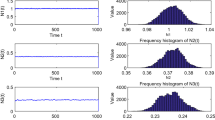Abstract.
The dynamic behaviour of food chains under chemostat conditions is studied. The microbial food chain consists of substrate (non-growing resources), bacteria (prey), ciliates (predator) and carnivore (top predator). The governing equations are formulated at the population level. Yet these equations are derived from a dynamic energy budget model formulated at the individual level. The resulting model is an autonomous system of four first-order ordinary differential equations. These food chains resemble those occuring in ecosystems. Then the prey is generally assumed to grow logistically. Therefore the model of these systems is formed by three first-order ordinary differential equations. As with these ecosystems, there is chaotic behaviour of the autonomous microbial food chain under chemostat conditions with biologically relevant parameter values. It appears that the trajectories on the attractors consists of two superimposed oscillatory behaviours, a slow one for predator–top predator and a fast one for the prey–predator on one branch at which the top predator increases slowly. In some regions of the parameter space there are multiple attractors.
Similar content being viewed by others
Author information
Authors and Affiliations
Additional information
Received 8 November 1995; received in revised form 7 January 1997
Rights and permissions
About this article
Cite this article
Kooi, B., Boer, M. & Kooijman, S. Complex dynamic behaviour of autonomous microbial food chains. J Math Biol 36, 24–40 (1997). https://doi.org/10.1007/s002850050088
Issue Date:
DOI: https://doi.org/10.1007/s002850050088




